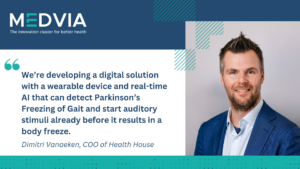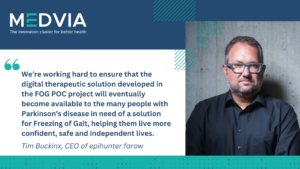The FOG POC consortium is developing a smart solution to prevent Freezing of Gait in Parkinson’s disease before it even begins, dramatically improving people’s quality of life. The solution integrates EEG signals, real-time AI and auditory stimuli to trigger the brain into resuming motion, preventing falls and facilitating independent living.

26 June 2024
Imagine you’re walking through a hallway when suddenly your feet seem to be glued to the floor. Your legs simply stop complying. A moment is all it takes; you might lose your balance and potentially helplessly fall to the ground.
This scenario is one faced by many people with Parkinson’s disease. The phenomenon is called Freezing of Gait (FOG) and is the most common reason for hospitalization in Parkinson’s.
Currently, there is no drug treatment for FOG. To tackle this medical need, MEDVIA has joined with several partners – KU Leuven, Sentigrate, epihunter farow, and Health House – to create a project called Freezing of Gait – Proof of Concept (FOG POC).
Trigger the brain back into motion
Before a person’s limbs freeze, Parkinson’s FOG first occurs in the brain. The FOG usually only lasts a few seconds, in which time the person experiences the frustration of thwarted locomotion as well as the risk of falls or accidents.

In that brief moment – between the initiation of the brain biomarker and the body freezing up – lies the hope for a solution. Researchers have discovered that it could be possible to start to trigger the brain back into action with auditory stimuli before the freeze actually happens. The auditory stimuli are specific sounds like the ticking of a metronome, music at a certain beat rate, or counting that cues the person back into motion.
“Of course, there are constraints with these findings,” says Dimitri Vanaeken, COO of Health House, the FOG POC project leader. “Playing specific music or the sound of a metronome throughout the day is entirely impractical – not only would it drive you crazy, but the effectiveness of the stimuli decreases as the brain learns to tune out the sound.”
Instead, the FOG POC project is using artificial intelligence to detect the occurrence of a freeze in the brain. “We’re developing a digital solution with a wearable device and real-time AI that can detect Parkinson’s Freezing of Gait and start auditory stimuli already before it results in a body freeze.”
A smart solution for brain signals
So, how does one develop a digital solution that can read brain signals on the go? The origins of the technology had already been developed in Flanders for a different purpose by the founder of epihunter farow.
Back in 2015, Tim Buckinx’s son asked him to create a solution to help him in school. Tim’s son has epilepsy, which manifests in absence seizures – episodes that, to his teacher and classmates, simply looked like daydreaming or zoning out in class.
“My son asked me: ‘Papa, you work in digital; can’t you create a headband that turns on a light when my brain switches off, so the teacher can see when I’m having a seizure and doesn’t get angry at me anymore?’” Buckinx shares. He founded a company to make the idea a reality, and epihunter’s smart seizure trackers are now available around the world.
Proof of Concept in Parkinson’s
The FOC POC project is using the platform and technology developed by epihunter farow to create a similar solution in Parkinson’s, bringing together small sensors in a headband with real-time AI running on a smartphone. The sensors are thin enough to be integrated into a hat or cap. The smart headband measures the electrical activity in the brain and uses real-time AI to identify the signal in the brain indicating that a freeze about to happen, and then automatically initiates the auditory stimuli via the smartphone to prevent the FOG from occurring.
“In 2025, we’re aiming to have a prototype that we can present to potential industry partners,” says Buckinx. “They can then help bring this technology to the market. We want this to be as user-friendly as possible, which is why we’re already involving people with the condition and their caregivers in this early stage of development.”
Patient-centric innovation
“Patient-centricity is a bit of a buzzword in the medtech industry,” Vanaeken muses. “But the power of this consortium is that the benefit is so tangible – for healthcare professionals, industry leaders and researchers, but especially for people with the condition and their loved ones.”
Health House in Leuven is very familiar with the patient experience. The center curates exhibitions on health innovation to inform and connect patients with each other and with researchers. Health House has an ongoing educational platform on Deep Brain Stimulation (DBS) for Parkinson’s disease and is integrating the FOG POC project into the storyline.
“When a person is approved for DBS, they’re often just sent home from the hospital with a brochure and are often left with a lot of questions and concerns,” says Vanaeken. “At Health House we bring patients together so that they can learn about their disease and possible treatments. They can connect and share their hopes and burdens, making it an informative experience but also a deeply personal one.”
They also share potential future solutions like FOG POC “to bring health innovation to their attention and to get them involved in the R&D process, if they’re interested,” says Vanaeken.
Partnering for the future
The next steps for FOG POC, in addition to refining the technology, is to develop a strategy for the future of the therapeutic solution. “Too many research projects end in a big report, and the health innovation never reaches the people who need it,” Vanaeken states.
This is where MEDVIA comes in: supporting the FOG POC’s go-to-market strategy by connecting the consortium with potential stakeholders who may be interested in continuing product development after the proof-of-concept project has concluded.
“There are a lot of industry players who could scale this project in the future, making sure the technology reaches people around the globe,” says Buckinx. “We’re working hard to ensure that the digital therapeutic solution developed in the FOG POC project will eventually become available to the many people with Parkinson’s disease in need of a solution for Freezing of Gait, helping them live more confident, safe and independent lives.”
By Amy LeBlanc



